Objects
Documentum uses an object-oriented model to store information within the repository. Everything stored in the repository participates in this object model in some way. For example, a user, a document, and a folder are all represented as objects. An object store s data in its properties (also known as attributes) and has methods that can be used to interact with the object.
Properties
A content item stored in the repository has an associated object to store its metadata. Since metadata is stored in object properties, the terms metadata and properties are used interchangeably. For example, a document stored in the repository may have its title, subject, and keywords stored in the associated object. However, note that objects can exist in the repository without an associated content item. Such objects are sometimes referred to as contentless objects. For example, user objects and permission set objects do not have any associated content.
Each object property has a data type, which can be one of boolean, integer, string, double, time, or ID. A boolean value is true or false. A string value consists of text. A double value is a floating point number. A time value represents a timestamp, including dates. An ID value represents an object ID that uniquely identifi es an object in the repository. Object IDs are discussed in detail later in this article.
A property can be single-valued or repeating. Each single-valued property holds one value. For example, the object_name property of a document contains one value and it is of type string. This means that the document can only have one name. On the other hand, keywords is a repeating property and can have multiple string values. For example, a document may have object_name='LoanApp_1234567891.txt' and keywords='John Doe','application','1234567891'.
The following figure shows a visual representation of this object. Typically, only properties are shown on the object while methods are shown when needed. Furthermore, only the properties relevant to the discussion are shown. Objects will be illustrated in this manner throughout the article series:
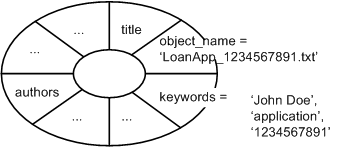
Methods
Methods are operations that can be performed on an object. An operation often alters some properties of the object. For example, the checkout method can be used to check out an object. Checking out an object sets the r_lock_owner property with the name of the user performing the checkout. Methods are usually invoked using Documentum Foundation Classes (DFCs) programmatically, though they can be indirectly invoked using API. In general, Documentum Query Language (DQL) cannot be used to invoke arbitrary methods on objects. DQL is discussed later in this article.
Note that the term method may be used in two different contexts within Documentum. A method as a defined operation on an object type is usually invoked programmatically through DFC. There is also the concept of a method representing code that can be invoked via a job, workflow activity, or a lifecycle operation. This qualification will be made explicit when the context is not clear.
Working with objects
We used Webtop for performing various operations on documents, where the term document referred to an object with content. Some of these operations are not specific to content and apply to objects in general. For example, checkout and checkin can be performed on contentless objects as well. On the other hand, import, export, and renditions deal specifi cally with content. Talking specifically about operations on metadata, we can view, modify, and export object properties using Webtop.
Viewing and editing properties
Using Webtop, object properties can be viewed using the View | Properties menu item, shortcut P, or the right-click context menu. The following screenshot shows the properties of the example object discussed earlier. Note that the same screen can be used to modify and save the properties as well.
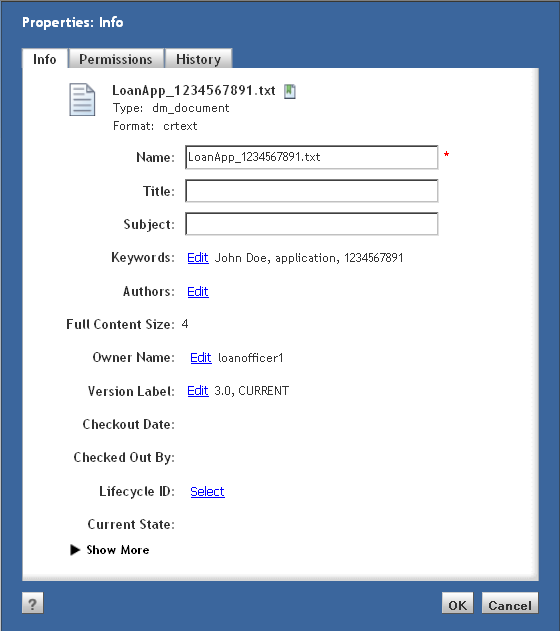
Multiple objects can be selected before viewing properties. In this case, a special dialog shows the common properties for the selected objects, as shown in the following figure. Any changes made on this dialog are applied to all the selected objects.
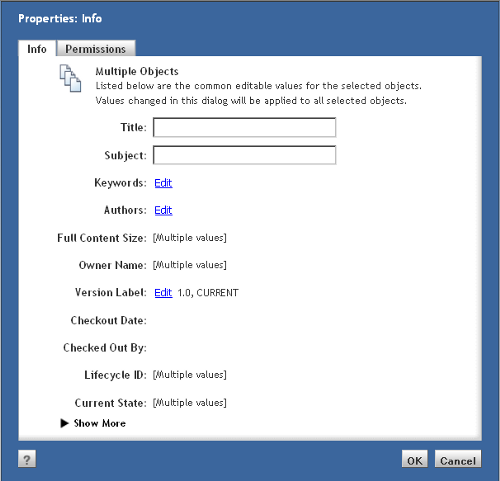
On the properties screen, single-valued properties can be edited directly while repeating properties provide a separate screen for editing through Edit links. Some properties cannot be modified by users at any time. Other properties may not be editable because object security prevents it or if the object is immutable.
Object immutability
Certain operations on an object mark it as immutable, which means that object properties cannot be changed. An object is marked immutable by setting r_immutable_flag to true. Content Server prevents changes to the content and metadata of an immutable object with the exception of a few special attributes that relate to the operations that are still allowed on immutable objects. For example, users can set a version label on the object, link the object to a folder, unlink it from a folder, delete it, change its lifecycle, and perform one of the lifecycle operations such as promote/demote/suspend/resume. The attributes affected by the allowed operations are allowed to be updated.
An object is marked immutable in the following situations:
- When an object is versioned or branched, it becomes an old version and is marked immutable.
- An object can be frozen which makes it immutable and imposes some other restrictions. Some virtual document operations can freeze the involved objects.
- A retention policy can make the documents under its control immutable. Certain operations such as unfreezing a document can reset the immutability flag making the object changeable again.
Exporting properties
Metadata can be exported from repository lists, such as folder contents and search results. Property values of the objects are exported and saved as a .csv (comma-separated values) file, which can be opened in Microsoft Excel or in a text editor. Metadata export can be performed using Tools | Export to CSV menu item or the right-click context menu. Before exporting the properties, the user is able to choose the properties to export from the available ones.
Unlock access to the largest independent learning library in Tech for FREE!
Get unlimited access to 7500+ expert-authored eBooks and video courses covering every tech area you can think of.
Renews at $19.99/month. Cancel anytime
Object types
Objects in a repository may represent different kinds of entities – one object may represent a workflow while another object may represent a document, for example. As a result, these objects may have different properties and methods. Every time Content Server creates an object, it needs to determine the properties and methods that the object is going to possess. This information comes from an object type (also referred to as type).
The term attribute is synonymous with property and the two are used interchangeably. It is common to use the term attribute when talking about a property name and to use property when referring to its value. We will use a dot notation to indicate that an attribute belongs to an object or a type. For example, objectA.title or dm_sysobject. object_name. This notation is succinct and unambiguous and is consistent with many programming languages.
An object type is a template for creating objects. In other words, an object is an instance of its type. A Documentum repository contains many predefined types and allows addition of new user-defined types (also known as custom types).
The most commonly used predefined object type for storing documents in the repository is dm_document. We have already seen how folders are used to organize documents. Folders are stored as objects of type dm_folder. A cabinet is a special kind of folder that does not have a parent folder and is stored as an object of type dm_cabinet. Users are represented as objects of type dm_user and a group of users is represented as an object of dm_group. Workflows use a process definition object of type dm_process, while the definition of a lifecycle is stored in an object of type dm_policy. The following figure shows some of these types:
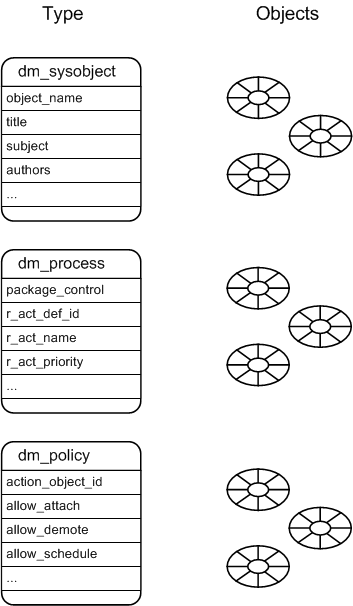
Just like everything else in the repository, a type is also represented as an object, which holds structural information about the type. This object is of type dm_type and stores information such as the name of the type, name of its supertype, and details about the attributes in the type. The following figure shows an object of type dm_document and an object of type dm_type representing dm_document. It also indicates how the type hierarchy information is stored in the object of type dm_type.
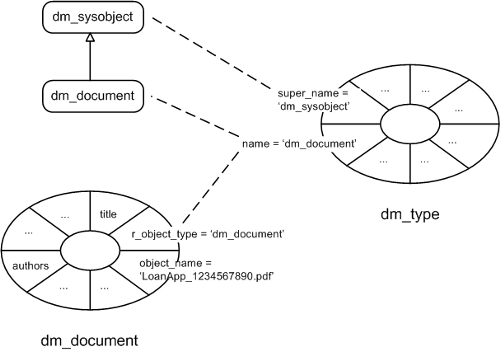
The types present in the repository can be viewed using Documentum Administrator (DA). The following screenshot shows some attributes for the type dm_sysobject. This screen provides controls to scroll through the attributes when there are a large number of attributes present. The Info tab provides information about the type other than the attributes.
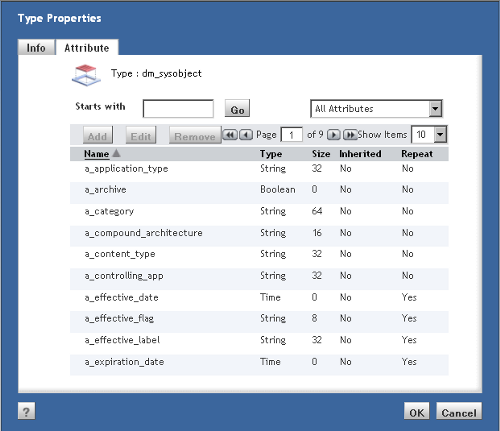
While the obvious use of a type is to define the structure and behavior of one kind of object, there is another very important utility of types. A type can be used to refer to all the objects of that type as a set. For example, queries restrict their scope by specifying a type where only the objects of that type are considered for matches. In our example scenario, the loan officer may want to search for all loan applications assigned to her. This query will be straightforward if there is an object type for loan applications. Queries are introduced later in this article.
As another example, audit events can be restricted to a particular object type resulting in only the objects of this type being audited.
Type names and property names
Each object type uses an internal type name, such as dm_document, which is used for uniquely identifying the type within queries and application code. Each type also has a label, which is a user-friendly name often used by applications for displaying information to the end users. For example, the type dm_document has the label Document.
Conventionally, internal names of predefined (defined by Documentum for Content Server or other client products) types start with dm, as described here:
- dm_: (general) represents commonly used object types such as dm_document, which is generally used for storing documents.
- dmr_: (read only) represents read-only object types such as dmr_content, which stores information about a content file.
- dmi_: (internal) represents internal object types such as dmi_workitem, which stores information about a task.
- dmc_: (client) represents object types supporting Documentum client applications. For example, dmc_calendar objects are used by Collaboration Services for holding calendar events.
Just like an object type each property also has an internal name and a label. For example, the label for property object_name is Name. There are some additional conventions for internal names for properties. These names may begin with the following prefixes:
- r_: (read only) normally indicates that the property is controlled by the Content Server and cannot be modified by users or applications. For example, r_object_id represents the unique ID for the object. On the other hand, r_version_label is an interesting property. It is a repeating property and has at least one value supplied by the Content Server while others may be supplied by users or applications.
- i_: (internal) is similar to r_ except that this property is used internally by the Content Server and normally not seen by users and applications. i_chronicle_id binds all the versions together in to a version tree and is managed by the Content Server.
- a_: (application) indicates that this property is intended to be used by applications and can be modified by applications and users. For example, the format of a document is stored in a_content_type. This property helps Webtop launch an appropriate desktop application to open a document. The other three prefixes can also be considered to imply system or non-application attributes, in general.
- _: (computed) indicates that this property is not stored in the repository and is computed by Content Server as needed. These properties are also normally read-only for applications. For example, each object has a property called _changed, which indicates whether it has been changed since it was last saved. Many of the computed properties are related to security and most are used for caching information in user sessions.
 United States
United States
 Great Britain
Great Britain
 India
India
 Germany
Germany
 France
France
 Canada
Canada
 Russia
Russia
 Spain
Spain
 Brazil
Brazil
 Australia
Australia
 Singapore
Singapore
 Canary Islands
Canary Islands
 Hungary
Hungary
 Ukraine
Ukraine
 Luxembourg
Luxembourg
 Estonia
Estonia
 Lithuania
Lithuania
 South Korea
South Korea
 Turkey
Turkey
 Switzerland
Switzerland
 Colombia
Colombia
 Taiwan
Taiwan
 Chile
Chile
 Norway
Norway
 Ecuador
Ecuador
 Indonesia
Indonesia
 New Zealand
New Zealand
 Cyprus
Cyprus
 Denmark
Denmark
 Finland
Finland
 Poland
Poland
 Malta
Malta
 Czechia
Czechia
 Austria
Austria
 Sweden
Sweden
 Italy
Italy
 Egypt
Egypt
 Belgium
Belgium
 Portugal
Portugal
 Slovenia
Slovenia
 Ireland
Ireland
 Romania
Romania
 Greece
Greece
 Argentina
Argentina
 Netherlands
Netherlands
 Bulgaria
Bulgaria
 Latvia
Latvia
 South Africa
South Africa
 Malaysia
Malaysia
 Japan
Japan
 Slovakia
Slovakia
 Philippines
Philippines
 Mexico
Mexico
 Thailand
Thailand




















